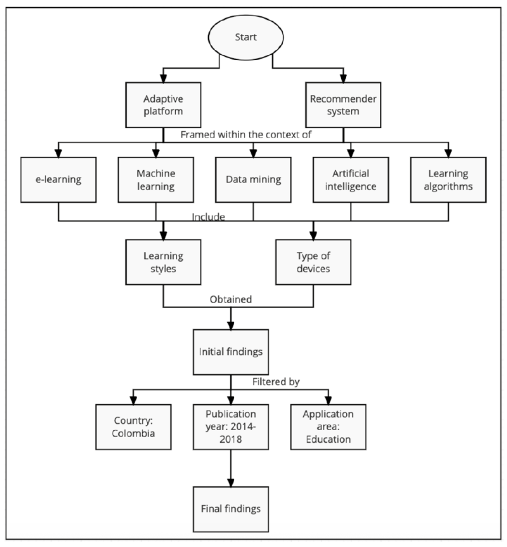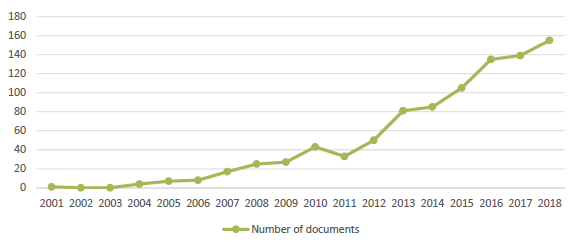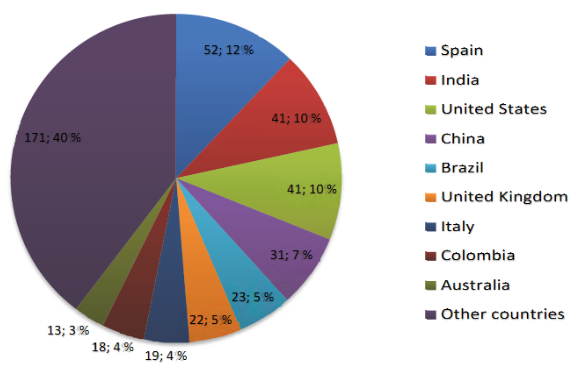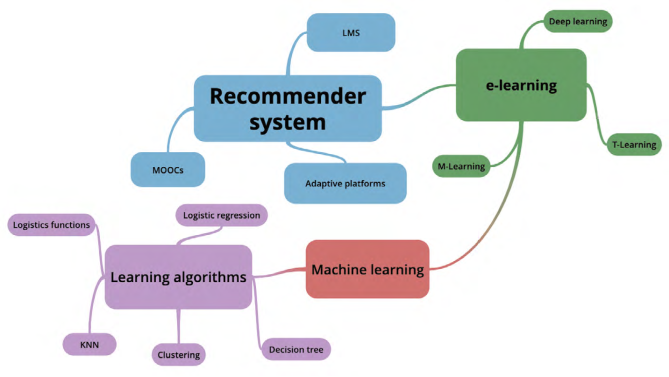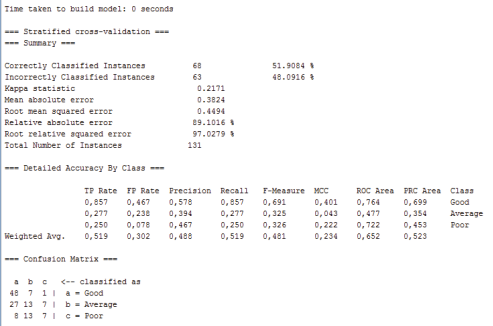INTRODUCTION
With the emergence of Information and Communication Technologies (ICT) a richer and more diverse access to any type of information was generated; richer regarding the amount of information that currently exists on the Internet or in specific data centers, and diverse, by the different tools through which it can be accessed (tablets, smartphones, computers, e-books and smart-watches) [1].
In this sense, the education sector is affected by these advancements, which makes it begin a migration and transformation of its traditional teaching and learning processes, breaking down barriers that existed in the past, such as the geographical and/ or temporal limitations of the traditional scheme [2]. According to this, new trends such as distance education, online educational platforms, MOOC and e-learning become a support to offer quality education in different ways.
This article presents the bibliographic review of current works about automatic learning mechanisms which is framed within a research project titled “Adaptive platform based on automatic learning mechanisms for the appropriation of technologies in students of high school of Popayan city”.
1. DEFINITION OF THE PROBLEM
Considering the premise that the emergence of new technologies has transformed and impacted society in different sectors [3], and especially the educational one and where the technological influence has changed the teaching paradigm, taking teachers to diversify their pedagogical practices and processes in function of information and communication technologies (ICT) so that they are more effective and efficient [4], models, systems, platforms and applications are developed to include technology in classrooms in order to facilitate learning for students. However, these systems should not only try to offer a list of educational resources independent of the tastes, preferences and characteristics of the users, but on the contrary, they should improve the educational experience. For this purpose, automatic learning mechanisms have been used to appropriately identify the information presented to each of the students and thus constantly improve the systems based on their experience, which helps to make better decisions [5].
Accordingly, there are still shortcomings in how educational resources are provided. Students receive information that is not consistent with their individual characteristics, learning styles and preferences; In addition, it does not take into account the technological resources or tools available in its environment, such as a computer, tablet, smartphone, Smart TV, devices to develop IoT (internet of things) projects, among others. In this sense, there is evidence of the need to have a system, platform and/or application that facilitates educational resources, learning from the students’ experience to make decisions aligned with their learning profile.
2. METHODOLOGY AND RESULTS
For the review of recommendation mechanisms presented in this paper, a search is made for works related to the development of an educational platform based on automa- tic learning mechanisms. In the first place, the keywords ro review were selected both in spanish an english. The keywords were: adaptive learning platform, recommender system, education/educative, adaptive learning, machine learning, learning style, E-learning, virtual learning environment.
Then, the search for related literature was made, looking for platforms-systems related with recommendation/adaptive focused on the educational/learning/machine learning fields. The search flow is represented in Figure 1.
In this first search, 21,444 results were obtained from 1933 to 2019. An analysis of the results between 2001 and 2018 shows a trend in the growth of work focused on deve- loping recommendation systems in the context of e-learning, as can be seen in Figure 2.
Filtering the search since 2015, 6,978 results were obtained and only 47 in Colombia. Although within the results of the search was emphasized learning and education, these were inclined towards platforms and applications in sectors like commerce, business and medicine. In this sense, a search equation is made that limits the results and are more specific for the educational sector. For this purpose, a search for an “adaptive platform” or “recommendation system” for “education” that integrates “E-learning” or “artificial intelligence” technologies is made and that considers the “learning styles” and the “devices” of the users. The search excludes medical, economics, physics, mathematics, psychology and arts sectors, and is limited to obtaining results since 2015. In this way, 431 results were obtained and only 18 in Colombia, as can be seen in Figure 3.
The search equation is presented in Table 1.
Table 1 Search equation
| Search Equation |
|---|
| (“plataforma adaptativa” OR “adaptative platform” OR “sistema de recomendación” OR “recommender system”) AND (“Educación” OR “Educational”) AND (“e-learning” OR “machine learning” OR “data mining” OR “minería de datos” OR “inteligencia artificial” OR “artificial intelligence” OR “algoritmos de aprendizaje” OR “learning algorithms”) AND (“estilos de aprendizaje” OR “learning styles” OR “devices” OR “dispositivos”) AND (LIMIT-TO (PUBYEAR, 2018) OR LIMIT-TO (PUBYEAR, 2017) OR LIMIT-TO (PUBYEAR, 2016) OR LIMIT-TO (PUBYEAR, 2015) OR LIMIT-TO (PUBYEAR , 2014) ) AND (EXCLUDE (SUBJAREA, “BUSI”) OR EXCLUDE (SUBJAREA, “ARTS”) OR EXCLUDE (SUBJAREA, “PSYC”) OR EXCLUDE (SUBJAREA, “ECON”) OR EXCLUDE (SUBJAREA, “MEDI”) OR EXCLUDE (SUBJAREA, “ENER”) OR EXCLUDE (SUBJAREA, “NEUR”) OR EXCLUDE (SUBJAREA, “MATE”) OR EXCLUDE (SUBJAREA, “PHYS”) OR EXCLUDE (SUBJAREA, “ENVI”) OR EXCLUDE (SUBJAREA, “BIOC”) OR EXCLUDE (SUBJAREA, “CHEM”) OR EXCLUDE (SUBJAREA, “AGRI”) OR EXCLUDE (SUBJAREA, “CENG”) OR EXCLUDE (SUBJAREA, “HEAL”) OR EXCLUDE (SUBJAREA, “PHAR”)) |
Source: Own elaboration
According to the results, the articles are analyzed with the following criteria:
1) Strictly linked with education, 2) Representation of a current state or summary of the technologies used in other related work, 3) High value proposal or solution for the development of the research project (regardless of the sector where it is applied). In this sense, the results are grouped into the following categories: I) Works that improve the student-educator relationship, II) Works that establish monitoring strategies to evaluate the learning practices. III) Works that evaluate techniques, algorithms and models to make recommendations in the teaching and learning processes.
II. Student-educator relationship
The study in [6], proposes a tool to link students with supervisors according to the experience, maximum workload and interest of the supervisor and the preferences of the students. In the article [7], data mining techniques are employed to examine unique patterns between the use of technology and experiences related to student learning, through this, the practice carried out by the teachers and the design of their learning route are reported.
II. Monitoring of learning practices
References [8] and [9] make recommendations based on information obtained through interactions or social networks, from which the student’s profile and learning style are extracted. In [10] they extract metadata from the visited OCW websites that commuted with the learning styles given by Felder Silverman’s theory suggesting the learning recommendations.
The authors of [11-13] propose a new approach to e-learning systems by integrating fuzzy logic models, the big data framework and the semantic web to make content adaptation to LMS platforms more effective. In [14] and [15] the authors developed a recommendations platform using artificial intelligence that can be adapted and customized for different use cases, taking into account the ecosystem and the daily life of the user.
In [16], the author presents a system of recommendations based on affective computing and collaborative filtering techniques. The authors of [17] and [18] present recommendation systems that are based on students’ needs and level of knowledge.
III. Evaluation of techniques, algorithms and models
The authors of [19] evaluate 12 popular automatic learning algorithms, including classification and regression trees, artificial neural networks and algorithms to determine similarity. In [20] the performance of the Naïve Bayes tree is evaluated to determine students’ learning styles. The authors of [21-23] present concepts and trends about e-learning and the use of data mining in education, concluding that it is a basic need to incorporate the learning styles and needs of students into the learning pathways designed by educators, also proposing an approach where MOOCs can be adapted and customized to the characteristics of students along with their learning pace.
Based on the results obtained in the search, a mental map is elaborated with the most outstanding keywords within it. According to the above, there is a trend in searches for recommendation systems in the context of e-learning, supervised learning algorithms, machine learning and its application in education. The mental map is presented in Figure 4.
3. EVALUATION
Since in the search the most used type of learning is the supervised one, a general evaluation of the most used algorithms within this type is made, these are: K-nearest neighbors (KNN), Naïve Bayes classifier, decision trees and logistic regression.
To perform the general evaluation of the mentioned above, a tool that includes the target algorithms within a larger collection of algorithms is used. For this purpose, the Weka tool is employed, which has the function of classifying supervised learning type algorithms. In this sense, this tool is chosen to perform the evaluation as realized in [24] and [25].
In that way, in order to execute the evaluation, a relevant test data set is searched for. This data set was found on the website UCI - Machine Learning Repository [26]; the data set Student Academics Performance is used. Table 2 presents the results of the evaluation of the algorithms.
Table 2 Evaluation results.
| Algorithms | Decision tree J48 | Naive Bayes | Logistics functions | KNN |
| % Success | 45.8 % | 54.19 % | 46.56 % | 51.9 % |
| Maximum accuracy | 0.530 | 0.667 | 0.613 | 0.578 |
| Recall | 0.625 | 0.750 | 0.679 | 0.857 |
Source: Own elaboration
An example of the results seen from the Weka tool is shown in Figure 5.
4. ANALYSIS
This research showed that there is a trend in searches for recommendation systems in the context of e-learning, supervised learning algorithms, machine learning and its application in education. Specifically, in the search algorithms, the most used type of learning is the supervised one. The evaluation of these kind of algorithms showed better success rates and maximum accuracy with the Naïve Bayes algorithm, and the best recall with the KNN algorithm, although the performance of the algorithms varies, there are no significant changes in the percentage success and maximum precision while the recall has a greater variation being the best results with the KNN and the Naïve Bayes in that order, among the evaluated algorithms.
5. CONCLUSIONS
The results obtained in the search show a need and a large commercial gap in Colombia to investigate, design and implement adaptive platforms that generate recommendations to enhance the education sector in terms of improving the process of teaching and learning through ICTs. On the other hand, determining learning styles and taking them into account in e-learning systems have become the fundamental basis for developing an efficient learning path for students; in addition, the level of knowledge and the pace of work of each student are important when generating recommendations.
Up to now, one of the most notable barriers to the incorporation of intelligent, distance, e-learning or MOOCS tutoring systems is the lack of awareness about the internet connection or the devices and tools through which students’ study outside or inside the classroom. It is important to highlight that during the search no significant articles were found that consider the above aspects and that mention them as barriers. Some of the techniques and algorithms most commonly used in the field of platforms or adaptive and recommendation systems are: Naïve Bayes, genetic algorithms, neural networks, fuzzy logic and multi-criteria collaborative filters. In this sense, it is evident that the technique most used for the construction of this kind of systems is supervised learning within automatic learning.













